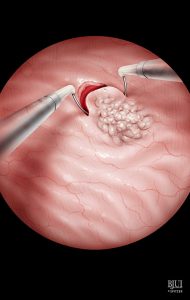Transurethral Resection of Bladder Tumour
What is Transurethral Resection of the Bladder Tumour?
Transurethral resection of bladder tumour (TURBT) is a procedure used to diagnose bladder cancer and remove any tumour or cancerous tissue from the bladder.
Who are Suitable for TURBT?
The TURBT procedure is limited to removing bladder cancers confined to the inner layers of the bladder. This is a diagnostic investigation to assess the extent of the tumour invasion (local stage) and the aggressiveness of the tumour (Grade).

Transurethral Resection of Bladder Tumour (TURBT)

Cystoscopic Appearance of Bladder Tumours
During TURBT Procedure
The surgery is performed under general or spinal anaesthesia. The complete surgical procedure takes about 30 minutes.
Your surgeon inserts a cystoscope (a thin tube with light and camera fitted at the end) into the bladder through the urethral opening (natural opening for the outflow of urine) to locate any tumour growth or cancerous tissue in the bladder.
An instrument called the resectoscope (a wire loop) is inserted through the cystoscope. Monopolar or Bipolar electric current is passed through the wire loop to cut away the cancerous tissue along with a margin of healthy tissue. If safe and feasible, Dr Kim also performs en-bloc resection (removal in one piece) of the bladder tumour for more accurate pathological assessment of its staging and grading.
After TURBT Procedure
A catheter (thin, flexible tube) may be inserted into the urethra and left in place for about 12-24 hours to avoid any blood clots formed in your bladder.
You typically go home next day after the surgery. Dr Kim may prescribe antibiotics to prevent infection and painkillers to provide relief from post-operative pain.
Like all surgical procedures, TURBT may involve complications such as blood in urine, pain and discomfort or even rare risk of bladder perforation. However, Dr Kim will discuss and weigh the benefits and risks with you in detail before performing the procedure.
